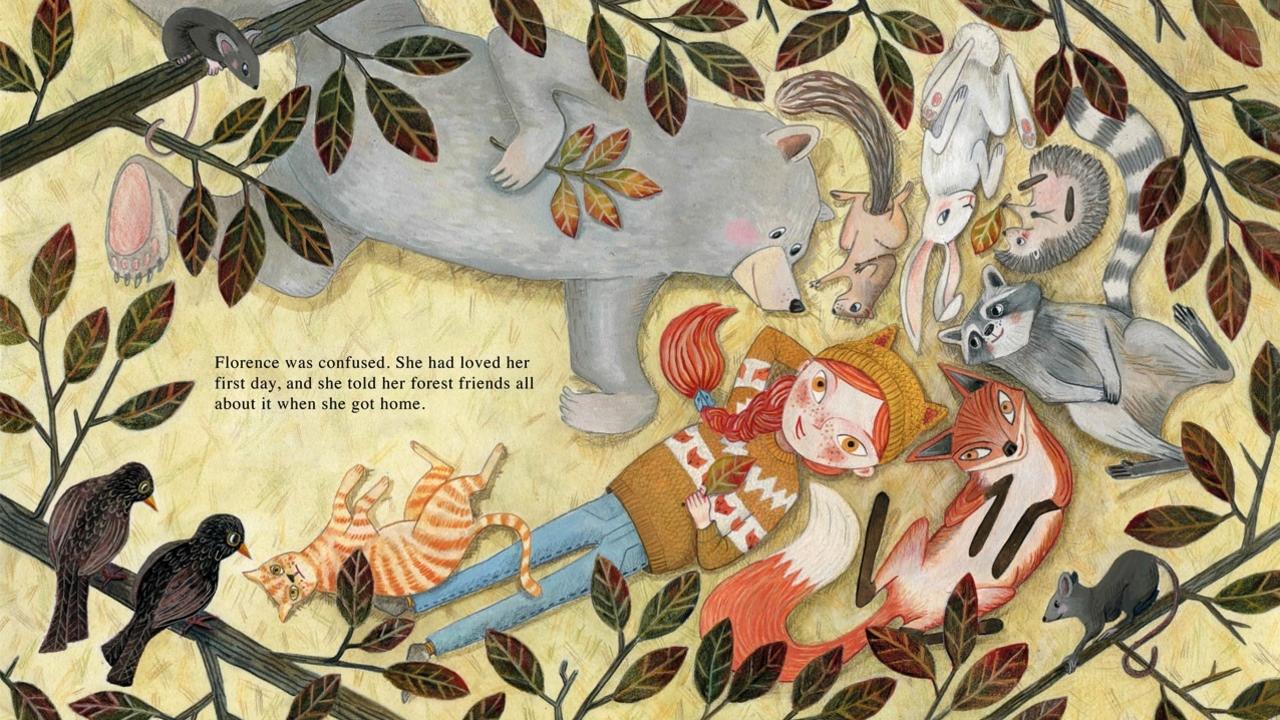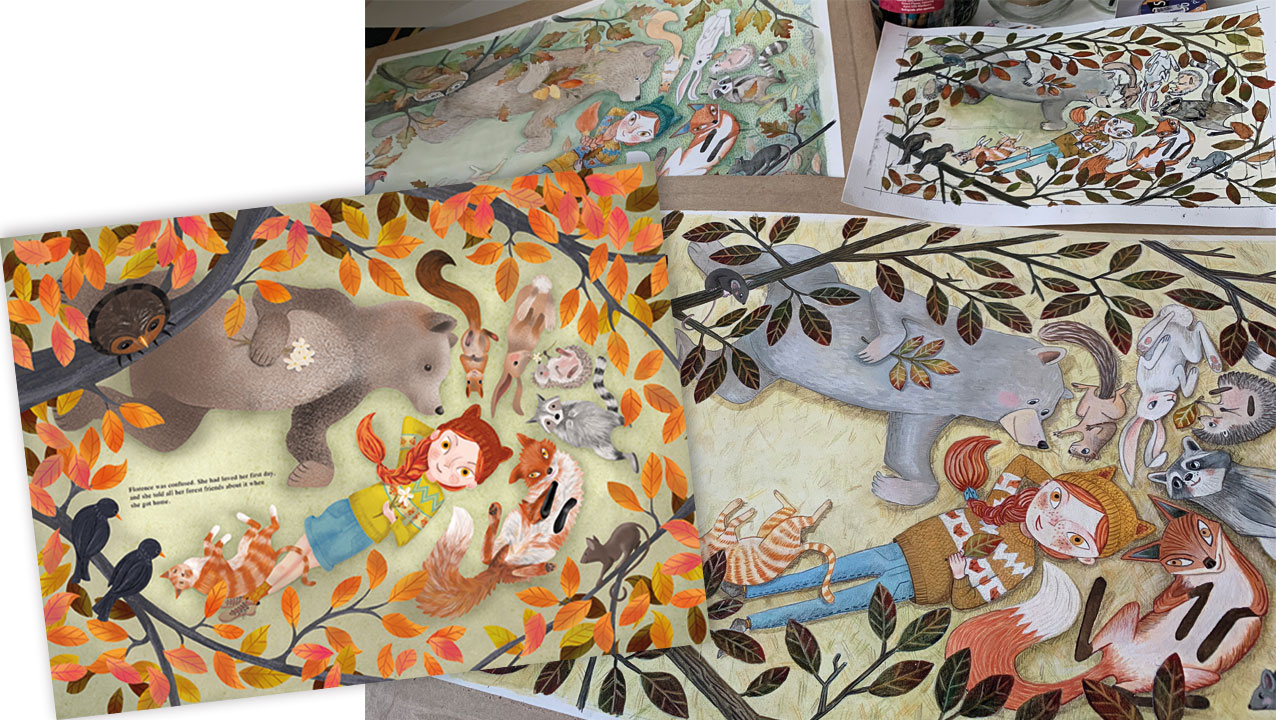How Lily Emo Illustrated Florence Fox

I first came across Lily's work, when she was shortlisted for the Gavin Bishop Award in 2019. So you can imagine how excited I was to have Lily join me for 8-weeks in the Picture Book Illustration e-Course (PBIC).

(Above, Lily's Gavin Bishop Award entry)
Although we both live in New Zealand, we haven't met in person ... yet, as I live in Auckland, in North Island and Lily lives in the South Island. So, it's a real privilege to be able to offer this online course so that people like Lily can not only take-part but also join a bustling online community of like-minded creative from all over the world.
The Picture Book Illustration e-Course is getting a Zhuzh!
Hearing how Lily (and other PBIC participants) wished that they'd had more time during the course, got me thinking. And as a result, the Picture Book Illustration e-Course is getting a Zhuzh! In a few months, the Picture Book Illustration e-Course will be re-released as a self-paced, 8-week course and workbook. If you're keen, make sure to register your interest at the bottom of this page.
You've probably seen Lily's delightful illustration splashed across the pages of my new website. Allow me to introduce you to Lily Emo as she talks about her journey in creating this Florence Fox illustration.
Take it away Lily!
My name is Lily Emo, I am from a little city called Nelson, New Zealand. When I’m not illustrating, I’m either working as a graphic designer, teaching art at the local high school or painting. So sometimes I find that I’m juggling a lot of different projects!

Describe your illustration style
I find it hard to describe my work, but I aspire to create illustrations that are charming, detailed, brimming with rich colour and characters. I sometimes use Procreate on my iPad and Photoshop, but what I love most, is the process of using traditional mediums like watercolour, gouache and graphite and coloured pencil.
 (Above, a sample of Lily's illustration portfolio)
(Above, a sample of Lily's illustration portfolio)
Why did you sign up to the Picture Book Illustration e-Course?
I’ve always made art and drawn pictures and I've always wanted to illustrate children’s picture books, but I felt like I lacked some of the knowledge of what was necessary to illustrate a children's picture book, which is why I signed up to the course.
Where do you work?
I am fortunate enough to have my own studio after renovating part of the garage. This is where I love to paint and do my design work. I also sometimes teach small classes in this space.
 (Above, Lily's workspace)
(Above, Lily's workspace)
How much time did you dedicate to the course?
I managed about five hours a week. It was quite a busy time, so I would've liked to have dedicated more time during the 8-weeks.
Walk us through the Picture Book Illustration e-Course
Did you have a plan before starting PBIC?
Nina recommended that I work on the class manuscript. This was a good choice as I liked having a clear brief and I knew that what I learnt during the course would easily translate to future picture book projects. Also, it was nice to share ideas with other participants, even though we were sharing ideas we all came up with such different ideas and styles.

(Above, Lily's storyboard)
What was the best thing about PBIC?
The best thing about the course was the content and feedback. Nina's resources were well researched, clear and very helpful. Nina gave really specific feedback in order to improve my work. Also, the PBIC Facebook group is a really supportive community.

What was the worst thing about PBIC?
The worst thing about the course was not having enough time. I was quite busy during the 8-weeks and felt like I was not able to spend the time I wanted too on the course. Thankfully, Nina offered access to the course videos and resources, so that I could revisit them later, which is what I did as I wanted to complete the project.
 (Above, Lily's animal character sketches)
(Above, Lily's animal character sketches)
Character Design
How did PBIC help with your character design process?
The course was invaluable in my character design process. What I found most useful were the tools that Nina offered on how to draw characters consistently in different poses. The character mapping process was helpful in getting proportions and consistency of character. This was something that I still need to practise, but the tips and tools have given me a good foundation. Nina has a character design series on Skillshare and she shared her Draw a Circus of Movement: Simple Techniques to Bring Characters to Life class with us, which was really helpful. I reviewed the class several times.

(Above, Lily's Florence Fox character sketches)
What was your experience receiving feedback?
I found the feedback really useful, she really helped me improve my illustrations in specific ways. I liked how Nina would give spontaneous Facebook live demonstrations when she wanted to show us all something that she felt would help us with our process.

(Above, Nina's feedback)
Storyboarding
Talk us through the process storyboarding process
The thumbnails are a good way to get initial ideas down quickly, though I still found that it took quite a lot of time. The good thing about the thumbnail process though is that you can do quick drawings without thinking too hard about proportions, these things can all be corrected later when you get to the larger storyboard.
Before I started my thumbnails, I made sure to read the course manuscript a couple of times, I then broke the story down into spreads for a 32-page picture book. This was challenging, I've done thumbnails before for a couple of illustration competitions I've entered but this was different. For the competitions, they had already decided page breaks, during PBIC, I got to choose the words for each page and play around with the pace rhythm and flow of the story.

(Lily's 'Florence Fox Goes To School' thumbnail sketches)
Once I completed my thumbnails, I then spent time working-up each individual double page spread into the larger storyboard format. This enabled me to refine my initial ideas.

(above, a sample from Lily's larger 'Florence Fox Goes To School' storyboard)
How did you choose your final illustration?
Once I completed the storyboard, I then needed to choose an illustration to take through to final artwork. I choose the sketch that appealed to me the most. Even as a draft, I felt the compositional elements of the page layout were most resolved. Northern hemisphere animals were unfamiliar to me, so some of the proportions (in the sketch below) were a bit out ... Nina's feedback with some sizing changes really helped.

(Lily's rough draft)
Did your illustration technique/style change or improve?
Because I was lacking time, I initially did my final illustration using Procreate on my iPad. (You do not need Procreate for this course by the way). But I felt that the result was too stiff and lacking. So, I took the time to develop and push my characters further. I ended up creating my final illustration using gouache and coloured pencil.
I felt that taking the time to revisit PBIC, allowed me to improve my characters, style and colour scheme. It took me a while to get the colours right, I ended up photocopying a lot of small versions of my final sketch on some cheaper watercolour paper to try out different colour combinations. This meant that when it came to the final illustration, I was more confident with what I was doing.
The Picture Book Illustration e-Course definitely helped me to improve my illustration in that I found new ways of working and pushing myself further.

(Lily's Procreate illustration, on the left)
Describe painting your final illustration
My journey of feelings while I was painting my final illustration went something like this ...
- excited but a little nervous about starting,
- then enjoying the process,
- then thinking ... ‘oh no this is not so good after all, what was I thinking’
- and then finally thinking, ‘This is ok, I'm happy with this’. :)
I am glad I persevered :)

(Lily's final artwork for 'Florence Fox Goes To School', written by Ben Whittacker-Cook)
What’s next for you?
Since the Picture Book Illustration e-Course, I've been working on my portfolio. My goal was to showcase my illustration portfolio at the KidLitVIc in Melbourne, Australia at the end of May, which was sadly postponed due to Covid-19.
During the lockdown, I found it really hard to concentrate on my illustration portfolio. So I decided to put it aside, and instead, I started a portrait project, illustrating Essential Workers and sharing their experiences of what it was like for them working during the lockdown. You can see my Covid-19 Portrait Project on Facebook @Covid19portraitproject.
It was a really positive way for me to process the craziness of the Covid-19 lockdown and to be able to acknowledge and share the stories of some of the New Zealand essential workers during this time. I'm excited to share that my Covid-19 Essential Workers Portrait Project will be exhibited at our local museum, Nelson Provincial Museum later this year.
My portfolio did get sidelined for a few months while I worked on the portrait project, but following a mentoring session with Nina, we made an illustration plan and I'm now back on track. I'm back in my studio getting my illustration portfolio ready to share with publishers.
And I still live in hope that the Trans-Tasman boarders will open so that I can attend the KidLitVic this November. Fingers crossed.
To find out more about Lily Emo, you can visit her website www.thescribbleforest.com and follow her on Instagram @lily.emo




